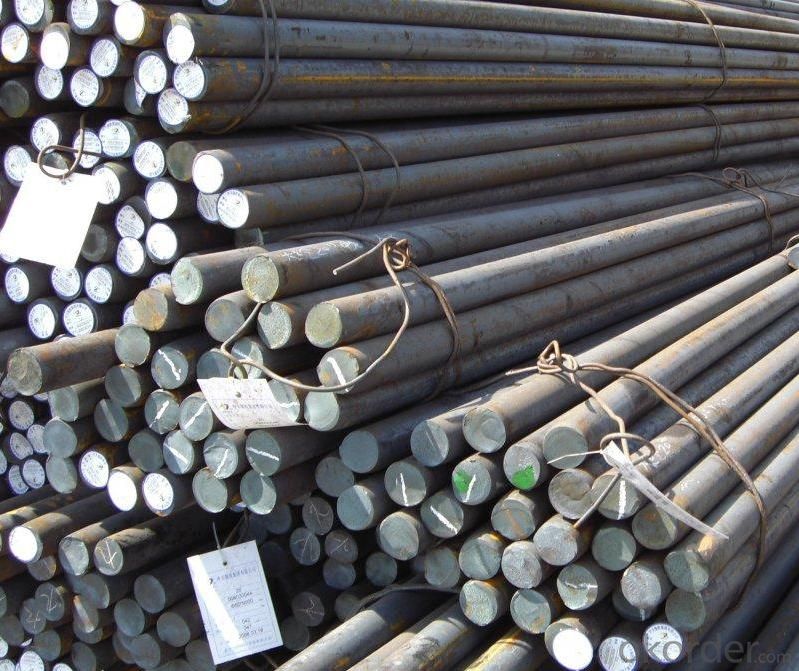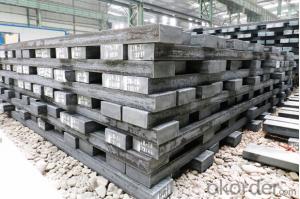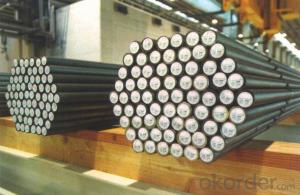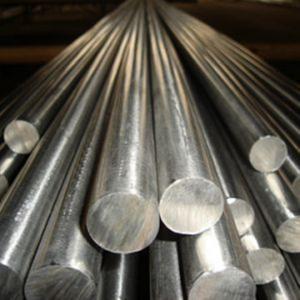S45C Forged Steel Round Bar for Building Material
- Loading Port:
- Tianjin
- Payment Terms:
- TT OR LC
- Min Order Qty:
- 25 m.t.
- Supply Capability:
- 50000 m.t./month
OKorder Service Pledge
OKorder Financial Service
You Might Also Like
Specification
S45C Forged Steel Round Bar for Building Material
Product Description:
1. Sizes: Diameter: 16mm-300mm; Length: 6m, 9m, 12m
2. Grade: S45C
3. Invoicing on theoretical weight or actual weight as customer’s request
4. Shape: Round bar, solid bar of steel with circular section
5. Technique: Hot rolled, forged, cold rolled
Chemical Composition:
C | Si | Mn | P | S | Ni | Cr | Cu |
0.42-0.50 | 0.17-0.37 | 0.50-0.80 | ≤0.035 | ≤0.035 | ≤0.30 | ≤0.25 | ≤0.25 |
Packing and Delivery:
Packing in bundle with steel strips and shipped by break bulk vessel or container (depend on target market and different ports)
Delivery Detail: Approx.45 days
Usage and Applications:
1. S45C Steel round bar is used in a large number of architectural and engineering structures. Or it can be used in construction of plants for the production of steel house frames, high-voltage transmission towers, bridges, vehicles, boilers, containers, ships, etc.
2. And we can use this kind of product on the performance of the mechanical parts if the demand is not very high.
3. Some especial material steel round bar can be used for main shaft of steamer, hummer shank, with big section and supper force.
Specification:
OD | Length | Material | Standard | Technique |
16-260mm | 6-12m or aques per request | 20# | GB ASTM DIN | Hot rolled |
16-350mm | S45C | |||
200-500mm | S45C | Forged | ||
20-250mm | 20Cr,40Cr,20-42CrMo | Hot rolled | ||
50-300mm | GCr15 |
Product show of S45C Steel:



- Q: How is special steel used in the construction manufacturing process?
- Special steel is commonly used in the construction manufacturing process due to its unique properties such as high strength, durability, and resistance to corrosion. It is used for various applications, including structural components, reinforcement bars, and fasteners. Special steel enhances the overall structural integrity of buildings, bridges, and other construction projects, ensuring their longevity and safety.
- Q: What are the different types of tool steel?
- There are several types of tool steel, including high-speed steel, cold work steel, hot work steel, and shock-resisting steel. Each type is specifically designed for different applications and has unique properties to withstand various conditions and demands. High-speed steel, for example, is known for its ability to retain hardness at high temperatures, making it suitable for cutting tools. Cold work steel is used for applications involving cutting, shearing, and forming metals at lower temperatures. Hot work steel, on the other hand, is designed to withstand high temperatures and is commonly used in die casting and forging. Lastly, shock-resisting steel is used in applications where the tool is subjected to high impact or sudden shocks, such as in chisels or hammers.
- Q: How does special steel contribute to the packaging aftermarket industry?
- Special steel plays a significant role in the packaging aftermarket industry by offering various benefits that contribute to the overall efficiency and quality of packaging processes. Firstly, special steel is known for its exceptional strength and durability, which makes it ideal for manufacturing packaging machinery and equipment. This robustness ensures that the machinery can withstand the rigorous demands of the industry, leading to increased reliability and reduced downtime. Additionally, special steel possesses excellent corrosion resistance properties, making it highly suitable for packaging applications that involve exposure to moisture, chemicals, or extreme temperatures. This resistance to corrosion helps to extend the lifespan of packaging equipment and prevents degradation, ultimately reducing maintenance costs and enhancing the overall efficiency of the packaging aftermarket industry. Moreover, special steel can be tailored to meet specific requirements, allowing for the production of customized packaging solutions. This flexibility and versatility enable manufacturers to create innovative designs that enhance product protection, optimize space utilization, and improve transportation logistics. For instance, special steel can be utilized to create lightweight yet sturdy packaging materials, reducing shipping costs and minimizing the environmental impact associated with packaging waste. Furthermore, special steel possesses excellent machinability and weldability, facilitating the fabrication of intricate packaging components with high precision. This capability enables manufacturers to produce packaging solutions that are tailored to specific product dimensions, ensuring a perfect fit and optimal protection during transit. In conclusion, special steel plays a crucial role in the packaging aftermarket industry by offering strength, durability, corrosion resistance, customization options, and excellent machinability. These qualities contribute to the overall efficiency, reliability, and quality of packaging processes, ultimately benefiting both manufacturers and consumers.
- Q: What are the different methods of surface ion nitriding for special steel?
- There are several methods of surface ion nitriding that can be used for special steel. These methods include: 1. DC Plasma Nitriding: This method involves the use of a direct current (DC) plasma to ionize nitrogen gas and create a plasma atmosphere. The special steel is placed in the plasma chamber and a high voltage is applied to accelerate the ions towards the surface of the steel, resulting in nitriding. 2. RF Plasma Nitriding: RF (Radio Frequency) plasma nitriding is a similar process to DC plasma nitriding, but instead of using a direct current, a radio frequency power supply is used to generate the plasma. This method allows for better control of the nitriding process and can be used for more complex geometries. 3. Pulse Plasma Nitriding: In this method, short pulses of high voltage are applied to the steel surface, creating a plasma discharge. The pulses are repeated at regular intervals, allowing for precise control over the nitriding process. This method is often used for steels with sensitive properties that can be affected by prolonged exposure to high temperatures. 4. Plasma Assisted Nitriding: This method combines plasma nitriding with other surface treatment techniques, such as physical vapor deposition (PVD) or chemical vapor deposition (CVD). The steel is first coated with a thin layer of a reactive material, and then nitrided in a plasma atmosphere. This combination of techniques can enhance the surface properties of the special steel, such as wear resistance or corrosion resistance. 5. Glow Discharge Nitriding: This method involves placing the special steel in a chamber filled with a nitrogen-rich gas, such as ammonia. A high voltage is applied to create a glow discharge, which ionizes the gas and generates nitrogen ions that diffuse into the surface of the steel. This method is commonly used for small parts or components with complex shapes. It is important to note that the selection of the most appropriate method for surface ion nitriding of special steel depends on factors such as the desired properties, the geometry of the steel, and the specific requirements of the application.
- Q: What are the cutting tools used for machining special steel?
- The cutting tools commonly used for machining special steel include carbide inserts, high-speed steel (HSS) drills, end mills, and broaches. These tools are specifically designed to withstand the high temperatures and hardness of special steels, ensuring precise and efficient cutting operations.
- Q: Can special steel be used in the agricultural industry?
- Yes, special steel can be used in the agricultural industry. It is often utilized in the manufacturing of various farm equipment and machinery, such as plows, harrows, cultivators, and tractor components. Special steel's high strength, durability, and resistance to corrosion make it suitable for withstanding the demanding conditions and prolonged use in agricultural operations.
- Q: What are the properties of ultra-high-strength steel?
- Ultra-high-strength steel possesses exceptional mechanical properties, including high tensile strength, excellent toughness, and superior hardness. It typically exhibits a remarkable ability to withstand heavy loads, making it suitable for applications requiring exceptional strength-to-weight ratios. Additionally, ultra-high-strength steel often has good formability, allowing for complex shapes to be manufactured. It is commonly used in sectors such as automotive, aerospace, and construction, where strength and durability are paramount.
- Q: How does special steel contribute to the defense sector?
- The defense sector relies heavily on special steel, which offers numerous benefits and applications that bolster national security. First and foremost, special steel is renowned for its exceptional strength, durability, and resistance to wear and corrosion. These attributes make it an ideal material for manufacturing military equipment and weapons. Tanks, armored vehicles, naval ships, and aircraft carriers all benefit from the structural integrity and protection against enemy attacks provided by special steel. Furthermore, the use of special steel in ballistic armor and bulletproof vests enhances the safety of soldiers on the battlefield. Additionally, special steel alloys possess remarkable thermal resistance and high-temperature capabilities, making them suitable for producing jet engines, turbines, and rocket components. These materials can withstand extreme conditions, enabling faster and more efficient military aircraft, missiles, and vehicles used in space exploration. Moreover, special steel's electromagnetic properties make it invaluable in the defense sector. It is employed in developing radar systems, communication devices, and electronic warfare equipment. Special steel alloys effectively shield against electromagnetic interference, ensuring secure and reliable communication during critical defense operations. Furthermore, special steel plays a vital role in the production of precision tools and machinery used in the defense sector. With its high machinability, special steel enables the fabrication of complex components with tight tolerances. Military-grade cutting tools, drills, and machine parts are manufactured using special steel, thereby enhancing the efficiency and effectiveness of military operations. In conclusion, special steel significantly contributes to the defense sector by providing crucial properties such as strength, durability, resistance, and more. Its applications in military equipment, weaponry, armored vehicles, aircraft, and electronic systems not only enhance national security but also protect soldiers and enable advanced defense capabilities.
- Q: How does the microstructure of special steel affect its performance?
- The microstructure of special steel plays a crucial role in determining its performance. It influences various mechanical properties such as strength, hardness, toughness, and wear resistance. By controlling the arrangement and size of the steel's grains, as well as the presence of any additional phases, manufacturers can tailor the material to meet specific requirements. For instance, a finer grain structure can enhance strength and hardness, while a uniform distribution of carbides can improve wear resistance. Consequently, optimizing the microstructure allows special steel to exhibit superior performance characteristics in specific applications.
- Q: What are the different methods for tempering special steel?
- There are several methods for tempering special steel, each with its own advantages and considerations. Some of the common methods used for tempering special steel include: 1. Air Tempering: This method involves heating the steel to a specific temperature and then allowing it to cool in still air. Air tempering is often used for low alloy steels and results in a uniform hardness throughout the steel. 2. Oil Tempering: In this method, the steel is heated to a specific temperature and then quenched in oil to cool it rapidly. Oil tempering is commonly used for tool steels as it provides a good balance between hardness and toughness. 3. Water Tempering: Similar to oil tempering, water tempering involves quenching the steel in water after heating it to a specific temperature. This method provides a higher rate of cooling and results in a harder steel, but it may also lead to increased brittleness. 4. Salt Bath Tempering: In this method, the steel is immersed in a molten salt bath at a specific temperature. The salt bath provides a more controlled and uniform heat transfer, resulting in a consistent hardness throughout the steel. 5. Cryogenic Tempering: Cryogenic tempering involves cooling the steel to extremely low temperatures, often below -100°C (-148°F), using liquid nitrogen or helium. This method helps to further reduce residual stresses and increase the wear resistance of the steel. It is important to note that the specific method chosen for tempering special steel depends on various factors, including the type of steel, desired hardness, intended application, and the desired balance between hardness and toughness. It is crucial to follow proper heat treatment guidelines and consult with experts to ensure the best results for a specific steel alloy.
Send your message to us
S45C Forged Steel Round Bar for Building Material
- Loading Port:
- Tianjin
- Payment Terms:
- TT OR LC
- Min Order Qty:
- 25 m.t.
- Supply Capability:
- 50000 m.t./month
OKorder Service Pledge
OKorder Financial Service
Similar products
Hot products
Hot Searches
Related keywords






























